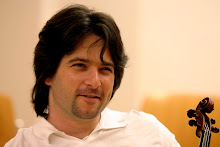Perhaps the biggest problem violinists have is the way the instrument is held. The unnatural way of holding the violin, combined with the difference in physical build of each individual student make the whole issue quite complicated and the solution personal.
There are two issues that need to be addressed: the angle of the violin, which is held by the body and the proportion between supporting the violin with the neck and the hand.
Ideally, the violin should be resting on the collar bone although for many players with a long neck it is simply not an option. What I would make sure, though, is that the violin should be stable. When you lift the head from the chin rest the violin should not slip downwards. This is very important because if the violin is held in a steep angle, the violinist would always clasp the instrument between shoulder and neck without any relief. This is one of the biggest causes of injuries, since the damage to the muscles and even bones is accomulated over time.
Another problem caused by a bad violin hold is that the instrument “falls” into the palm of the left hand, meanning that the support for the violin neck comes from the right side (from the violinist point of view). That makes the violinist clasp the neck and makes vibrato, a movement which demands freedom, a difficult task.
How we support the violin is crucially important. Ergardless of the silly notion that the violin should be only held by our own neck, if you clasp the violin’s neck from the sides, leaving the underneath free, the violin will always drop when you release the grasp. The outcome of such hold is that the violinist never releases the grasp from both sides of the violin’s neck, restrichting vibrato and shifting.
The 4th position is perhaps the easiest, physically the most comfortable position for holding the violin and why? Because the thumb gives the best support from underneath the neck, so the hand holds the violin from the down and up sides instead of the right and left side of the neck.
Ideally the violin’s neck should be supported from bellow and it is up to you to try to find the best hand position to follow such ideal. Some people prefer using the lower part of the thumb, which curls underneath the neck, others prefer to use the upper part of the thumb as support.
